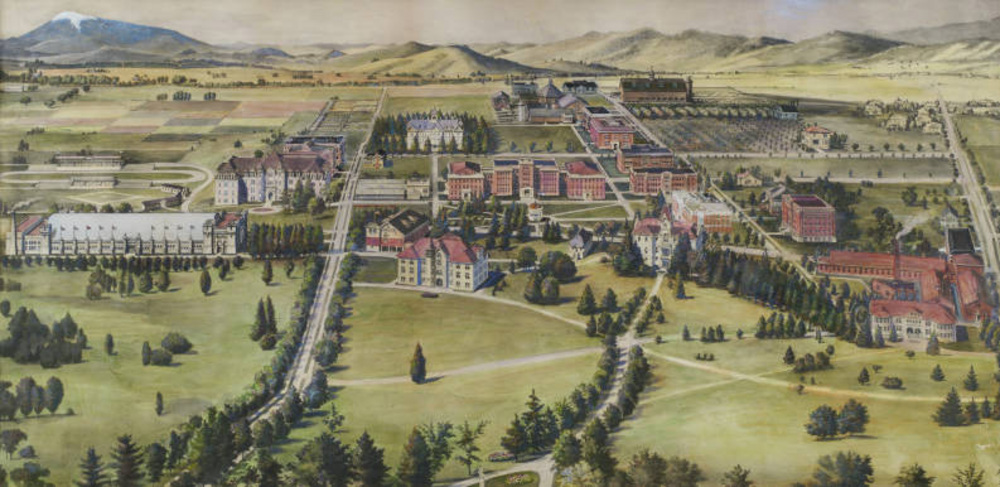A groundbreaking climate scientist, Warren M. Washington played a major role in the scientific understanding of global warming and made important contributions to modeling the world’s weather patterns. A Portland native and graduate of Oregon State College, he was among the earliest generation of scientists to use computers to develop powerful models of the Earth's weather systems. He had a long and distinguished career at the National Center for Atmospheric Research and contributed to the Intergovernmental Panel on Climate Change working group, which shared the 2007 Nobel Peace Prize for its efforts to better understand and help fight the effects of global warming.
Warren Morton Washington was born in Portland on August 18, 1936, one of five siblings. Both of his parents, who had moved to Oregon from the South, were college-educated. His father Edwin worked as a waiter for the Southern Pacific Railroad and his mother Dorothy was a homemaker. Raised in the northeast part of the city, he attended Jefferson High School, where, buoyed by the encouragement of his teachers, he cultivated a facility for mathematics and a love of scientific research. He also developed community connections with local civil rights leaders and was a vice chair of the Junior NAACP chapter.
Washington enrolled at Oregon State College (now Oregon State University) in 1954, choosing the school in part because he found work as a handyman at a Corvallis hospital. One of a handful of Black students at OSC, he excelled in math and received a well-rounded physics education that included an introduction to computing systems. A general meteorology course from physics professor Fred Decker contributed to his decision to stay at OSC for graduate studies in atmospheric sciences. While pursuing a thesis on wave clouds created in mountainous environments during rainfall events, Washington spent hours on Marys Peak with Decker, operating a weather radar station. He also spent a summer at the Stanford Research Institute, where he assisted with atmospheric computer modeling calculations.
Completing his master’s degree in 1960, Washington began doctoral work at Pennsylvania State University, where he focused on the analysis of data in the stratosphere. His research sought to find solutions for how best to compile weather forecasts in situations where regional data are incomplete. Using the FORTRAN programming language, he developed a novel method for interpolating data that improved on existing methods and led to more accurate computer models of changing weather patterns. He completed his PhD in three years, the second African American in the nation to earn a doctorate in the field.
In 1963, the National Center for Atmospheric Research in Boulder, Colorado, hired Washington as a research scientist. Founded in 1960 and funded by the National Science Foundation, NCAR was equipped with powerful computers and was charged with tackling projects that were too large for academic departments to take on. The environment suited Washington, and early in his tenure he collaborated with fellow NCAR scientist Akira Kasahara to develop a computer model of the world’s climate system. As part of that work, his group created the first simulations of monsoons in India, which they coupled with atmospheric and oceanic observations to compile a global map of ocean temperatures. That map, which was published in an era that preceded the widespread use of weather satellites, proved foundational to other climate scientists, who leaned on the data to further their own research projects.
During the 1970s, Washington and other NCAR scientists were involved with early efforts to model increases in greenhouse gases and the resulting changes in the Earth’s climate. With new iterations of those models, the impact of greenhouse gases became clearer. A few years later, the Carter administration asked Washington to join a committee of scientific advisors to provide guidance on issues related to the atmosphere and oceans. From 1994 to 2006, he was a member and chair (2002–2006) of the National Science Board. During his career, he has served as scientific advisor to six U.S. presidential administrations.
Washington was also part of the Intergovernmental Panel on Climate Change. The IPCC was formed in 1988 to provide data to world leaders that might better inform decision-making about climate change. Importantly, the IPCC was also comprised of atmospheric scientists who had developed their own, sometimes competing, models of global warming. Similar to the impact of his ocean temperature map, certain of those models relied heavily on work that Washington had published years before.
An IPCC working group, to which Washington and others from NCAR contributed, agreed to run the same set of standard experiments charting increases in carbon dioxide in the environment, with the goal of reaching and articulating scientific consensus on the import of climate change. A first assessment report was issued in 1990, with subsequent reports published in 1995, 2001, 2007, and 2014. Despite the differences in the models used, all of the experiments showed an increase in warming that connected with rising levels of carbon dioxide in the atmosphere. These data were summarized for use by scientists and policymakers and disseminated to governments around the world.
In 2007, the same year the fourth assessment report was published, the IPCC shared the Nobel Peace Prize with former Vice President Al Gore “for their efforts to build up and disseminate greater knowledge about man-made climate change, and to lay the foundations for the measures that are needed to counteract such change.” Three years later, the Obama administration recognized Washington with the National Medal of Science for his research breakthroughs and “his work to support a diverse science and engineering workforce,” a nod in part to his mentorship of students from underrepresented communities participating in the SOARS (Significant Opportunities in Atmospheric Research and Science) program.
Washington is a past president of the American Meteorological Society (1994) and fellow of the American Geophysical Union. He is the author of more than 150 academic publications and a seminal textbook, An Introduction to Three-Dimensional Climate Modeling, co-written with NASA scientist Claire Parkinson (2nd edition, 2005). He retired from NCAR in 2018. He and climatologist Michael E. Mann shared the prestigious Tyler Prize for Environmental Achievement in 2019. In 2020, the American Meteorological Society created the Warren Washington Research and Leadership Medal in his honor. Washington died on October 18, 2024.
-
![]()
Warren Washington.
Courtesy National Center for Atmospheric Research -
![]()
Warren Washington, 2019.
Courtesy Oregon State University -
![]()
Warren Washington, 1993.
Courtesy Oregon State University Libraries -
![]()
Warren Washington receives the National Medal of Science from Barack Obama, 2010.
Courtesy the White House, NCAR
Related Entries
-
![Climate Change in Oregon]()
Climate Change in Oregon
Within a few hundred miles in Oregon, you can see snowy volcanoes, parc…
-
![Dominique Bachelet (1957–)]()
Dominique Bachelet (1957–)
Dominique Bachelet is a climate scientist and science communications sp…
-
![Jane Ann Lubchenco (1947–)]()
Jane Ann Lubchenco (1947–)
Jane Lubchenco is an internationally recognized environmental scientist…
-
![Oregon Climate Change Research Institute]()
Oregon Climate Change Research Institute
The Oregon Climate Change Research Institute was established in 2007 to…
-
![Oregon Global Warming Commission]()
Oregon Global Warming Commission
The Oregon legislature created the Oregon Global Warming Commission in …
-
![Oregon State University]()
Oregon State University
Oregon State University (OSU) traces its roots to 1856, when Corvallis …
Map This on the Oregon History WayFinder
The Oregon History Wayfinder is an interactive map that identifies significant places, people, and events in Oregon history.
Further Reading
Washington, Warren M. and Mary C. Washington, eds. Odyssey in Climate Modeling, Global Warming and Advising Five Presidents, (2nd ed.). Morrisville, NC: Lulu.com, 2008.
Warren Washington Oral History Interview, May 29, 2015. Conducted by Chris Petersen. Oregon State University Sesquicentennial Oral History Collection (OH 26), Special Collections and Archives Research Center, Oregon State University Libraries.
Warren Washington Online Exhibit and Timeline, National Center for Atmospheric Research Archives










